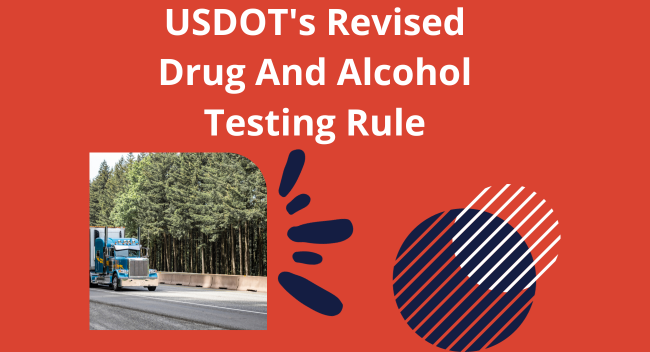
USDOT’s Revised Drug and Alcohol Testing Rule
The USDOT recently revised the rules for its drug and alcohol testing program in 2023. Learn more about it here.

The United States requires all employees and personnel who operate commercial motor vehicles and perform safety-sensitive functions to undergo a series of drug and alcohol testing and evaluation processes to ensure road safety.
Recently, there have been updates to the drug and alcohol testing rules, which were implemented last June 1, 2023.
The revised drug and alcohol testing regulations aim to improve roadway safety by increasing the testing coverage of employees, as well as several other additions and updates to existing rules.
Overview of the Revised Drug and Alcohol Testing Rule
USDOT established the Federal Motor Carrier Safety Administration (FMCSA) on January 1st, 2000, to promote the safe transport of goods and passengers across the United States.
The FMCSA is a department within the Department of Transportation (DOT) that sets and enforces federal rules that govern drug and alcohol testing for those operating commercial motor vehicles.
The revised drug and alcohol testing rule applies to employers, employees, and service agents involved in safety-sensitive functions of interstate and intrastate commerce.
More specifically, the amendments were applied to 49 CFR Part 40, which outlines the procedures for the collection, handling, and testing of specimens.
Key Changes to the Revised Drug and Alcohol Testing Rule
The revised regulations make several changes to the existing drug and alcohol testing process. Here are some of the most important updates:
Change 1: If a drug or alcohol test is given to determine an employee’s medical qualification for a license or certificate as part of their physical examination, it is not considered a DOT drug or alcohol test.
Change 2: Only DOT-regulated employees can undergo a DOT drug or alcohol test. Additionally, employers must ensure that the employees are not tested more than what is required.
Change 3: If an employee’s drug or alcohol test comes back negative and is verified, they won’t need to provide a different sample for the same test. However, if the test is canceled, the employee may have to provide a new sample during a re-collection.
Change 4: Oral fluid specimens are now permitted for DOT drug testing, in addition to urine and breath specimens.
Change 5: Employees cannot collect their own specimens even if they are qualified to do so.
Change 6: There are additional training requirements for screening test technicians for the collection of oral fluid specimens.
Change 7: You must use the current (2020) version of the Federal Drug Testing Custody and Control Form (CCF) for an oral fluid specimen.
Change 8: There are additional requirements for DOT drug and alcohol testing sites to ensure the facilities are equipped to meet all current standards.
Change 9: There are new materials for specimen collection and preservation, particularly for oral fluid specimens.
Change 10: If a C/TPA (third-party administrator) has asked an employee to appear for drug and alcohol testing and the employee fails to do so, the designated employer representative (DER) must determine if the employee refused to test.
Change 11: Revisions for the collection process for nonbinary and transgender employees.
Change 12: New cutoff concentrations for urine drug tests, which apply to testing for marijuana, cocaine, amphetamines, phencyclidine (PCP), and opioids.
Change 13: There are revisions to the guidelines for conducting validity testing of primary urine specimens.
Change 14: A medical review officer (MRO) can conduct a verification process at the employees’ pharmacy if said employees have tested positive due to prescription medication.
Change 15: There are additional amendments to the verification process for MROs.
Change 16: If employees do not provide sufficient specimens for a DOT drug test, collectors are required to provide another opportunity to do so.
Change 17: If a test is canceled due to a correctible flaw, only the MRO who canceled it can undo the cancellation. The MRO must do this within 60 days of the cancellation.
Change 18: The consequences of refusing a drug or alcohol test cannot be changed or disregarded by an arbitration, grievance, state court, or any other non-federal forum that rules on the employer’s decisions regarding the employee.
Change 19: Qualified substance abuse professionals (SAPs) cannot perform a remote evaluation that goes beyond their specified geographic limitations.
Change 20: Employers, SAPs, and other service agents are not allowed to give employees a copy of their drug and alcohol follow-up testing schedule.
Change 21: There is an additional section for the guidelines on drug and alcohol testing semi-annual laboratory reports.
Change 22: There are also additional guidelines for split specimen failure to reconfirm.
Change 23: The SAP equivalency requirements have been amended.
Change 24: There are specific guidelines for information that C/TPAs are allowed to share with employers.
A more detailed explanation of the revised drug and alcohol testing rule and its implications can be found on the website of USDOT.

Who Are Affected by the Revised Drug and Alcohol Testing Rule?
All safety-sensitive transportation employees, including those involved in marine transportation and passengers holding valid commercial driver’s licenses (CDL), are affected by the updates.
Employers, employees, and service agents involved in the safety-sensitive functions of interstate and intrastate commerce are also subject to the new rule.
For CDL drivers, this also means you must be aware of the drug and alcohol testing requirements for obtaining your medical certificate or license.
The revised rules are now in effect, meaning employers and employees must comply with the new guidelines or face potential penalties from USDOT.
Types of Drug and Alcohol Tests
Under the revised rules, there are additional drug and alcohol testing methods:
- Oral fluid tests: This is the newest addition to the USDOT drug and alcohol testing program, which is used to test for marijuana, cocaine, amphetamines, phencyclidine (PCP), and opioids. These tests use a mouth swab to determine the presence of drugs. This test can be used on its own or in combination with other drug and alcohol testing methods.
- Urine tests: These tests are used to detect the presence of drugs in a person’s system. Urine testing is one of the most common types of drug testing in the transportation industry.
- Breath tests: These tests measure the amount of alcohol in a person’s system. They are commonly used to determine the level of intoxication or impairment in drivers.
What Is Included in an Oral Fluid Collection Kit?
As part of the new rule, DOT-regulated employers must provide an oral fluid collection kit to any employee who is asked to take an oral fluid drug test. The kit includes the following:
- Sterile collection container
- Leak-resistant specimen bag with two sealable compartments
- Absorbent Material
- Instructions and chain of custody form
- Shipping container that will protect the specimen bottles
Who Are the Different Governing Bodies for the Revised Drug and Alcohol Testing Rules?
US Department Of Transportation (USDOT)
The US Department of Transportation (USDOT) enforces compliance requirements to ensure the safe transportation of goods and people.
These requirements cover various areas such as drug and alcohol testing, driver qualification, vehicle maintenance, hazardous materials transportation, and more.
Compliance with these requirements is mandatory for all transportation companies operating in the United States.
Examples of USDOT compliance requirements include:
- maintaining accurate driver logs
- conducting regular vehicle inspections
- complying with hours-of-service regulations
- ensuring that drivers are properly licensed and trained
Federal Motor Carrier Safety Administration (FMCSA)
The Federal Motor Carrier Safety Administration (FMCSA) is responsible for enforcing the revised drug and alcohol testing rule for transportation companies operating in the US.
The FMCSA also maintains a database of drivers who have violated drug and alcohol testing regulations, known as the Commercial Driver’s License Drug and Alcohol Clearinghouse.
This database is used to track violations and ensure that drivers are not allowed to continue driving while under the influence of drugs or alcohol.
Pipeline and Hazardous Materials Safety Administration (PHMSA)
The Pipeline and Hazardous Materials Safety Administration (PHMSA) is responsible for enforcing the revised drug and alcohol testing program for companies that transport hazardous materials in the US.
Federal Transit Authority (FTA)
The Federal Transit Administration (FTA) is responsible for enforcing the revised drug and alcohol testing program for companies that provide public transportation services in the US.
Additionally, the FTA provides guidance and technical assistance to transportation companies to ensure they are in compliance with these regulations.
The FTA also maintains a National Transit Database (NTD) that collects and analyzes data related to drug and alcohol testing and other aspects of transit operations.

Stay Compliant with the New Drug and Alcohol Testing Rules
It is crucial for transportation companies to stay informed of the rules and ensure they are following all the guidelines. Failure to do so can result in hefty penalties and potential liability issues.
However, keeping up with the changes in drug and alcohol testing regulations can be a challenge. DOT Compliance Group can lend you a hand. Our team of experts can help you understand the updated rules and ensure your company is compliant with all regulations.
Contact us today at https://www.dotcompliancegroup.com to learn more about how we can help you stay compliant with the new drug and alcohol testing rules.
